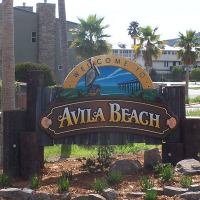Chevron Plans Avila Beach Resort in Area Once Devastated by Oil Pollution

It has been 25 years since an oil company destroyed the town of Avila Beach in San Luis Obispo County, saturating the land beneath it with a sea of goo that took a decade to clean up.
Now it’s time for Chevron, which inherited some valuable beachfront property there when it swallowed up Unocal in 2005, to make some money.
The oil company has proposed building a hotel resort on cliffs overlooking the ocean, at a site that was once home to an oil tanker farm. But first, Chevron needs to get the 95 acres rezoned from industrial to recreational, clean up some lingering gunk and overcome the bitterness of the few people left behind after Avila Beach was ruined.
Union Oil Co. built its facility in the unincorporated area just southwest of San Luis Obispo in 1906, flowing oil from it through underground pipes to a pier where tankers took on the load. The pipes went right through the heart of town and, according to the Los Angeles Times, by World War II were delivering 2 million gallons of crude oil a day to waiting ships.
In 1989, residents there realized they had a problem. Oil, diesel fuel and gasoline were oozing out of the ground and it quickly became apparent that years of pollution from corroded pipes had ruined the area. Bulldozers flattened much of the town and many of the 400 residents backed away in horror. Large expanses of earth were excavated, sometimes 15 feet deep, and 300,000 cubic yards of dirt were removed.
The town sat on what was, in effect, a 400,000-gallon toxic reservoir. The entire business district had to be eviscerated, along with six square blocks of homes. Unocal fought against calls for a settlement for a decade, before finally capitulating.
The state accused the oil company of contaminating groundwater and a nearby creek, and the oil company, then known as Unocal, paid $200 million to begin the process of cleaning up and rebuilding. It was one of the largest environmental settlements in California history at the time. Historical structures were knocked down and what had once been a divey, funky, working class town was replaced by something a bit more upscale.
The San Francisco Chronicle, in 1998, said of the deal, “Unocal will literally destroy the San Luis Obispo County hamlet in order to save it.”
Despite being just six miles south of the Diablo Canyon Nuclear Power Plant, tourism became its single most important generator of economic well-being. The population of Avila Beach was 1,627 as of the 2010 Census.
Early plans by Chevron indicate a desire to build a 100-room hotel, 95 cottages, a spa, a restaurant and an amphitheater. More than half the land would be preserved as open space, with a coastal trail snaking through a natural habitat that hasn’t been accessible by the public for a century.
Chevron wants to start building in 2017.
–Ken Broder
To Learn More:
Hotel, Trails Could Take Shape at Former Tank Farm near Avila Beach (by David Sneed, San Luis Obispo Tribune)
In Quaint Avila Beach, Oil Firm Plans Resort Where Crude Once Spilled (by Scott Gold, Los Angeles Times)
Unocal to Tear Down Toxic Town—and Rebuild It (by Glen Martin, San Francisco Chronicle)
- Top Stories
- Controversies
- Where is the Money Going?
- California and the Nation
- Appointments and Resignations
- Unusual News
- Latest News
- California Forbids U.S. Immigration Agents from Pretending to be Police
- California Lawmakers Urged to Strip “Self-Dealing” Tax Board of Its Duties
- Big Oil’s Grip on California
- Santa Cruz Police See Homeland Security Betrayal in Use of Gang Roundup as Cover for Immigration Raid
- Oil Companies Face Deadline to Stop Polluting California Groundwater





